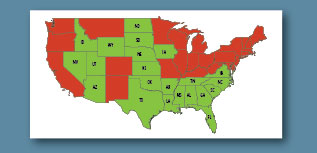| Organized labor sees this election cycle as its best opportunity ever to strike right-to-work provisions from the Taft-Hartley Act. Right to Work (RTW) “secures the right of employees to decide for themselves whether or not to join or financially support a union,” according to the National Right to Work Legal Defense Foundation. |
| |
| A comparison of fiscal performance and jobs creation in the 22 right-to-work states with non-right-to-work states shows they are strikingly dissimilar. Over the period 1996-2006, employment in RTW states (shown in the map at right) grew an average of 14.4%, while non-right-to-work states experienced job growth at half that level, 7.3%. |
| |
| From 2004-2007, real growth in gross state product in RTW states averaged 10.5%, while non-right-to-work states averaged 7.1% growth. Mississippi, the RTW state with the lowest real growth in gross state product at 5.1%, exceeded the growth rates of 15 non-right-to-work states. |
| |
| Given organized labor's strong opposition to the North American Free Trade Agreement (NAFTA),under the theory |
| |
|
|
| it exports jobs,one must assume unions wish to create job opportunities within the U.S. As usual, unions are looking through the wrong end of the telescope if they think their aims are furthered by overturning RTW laws. |
| |
 |
| [Place cursor over map to enlarge] |
|